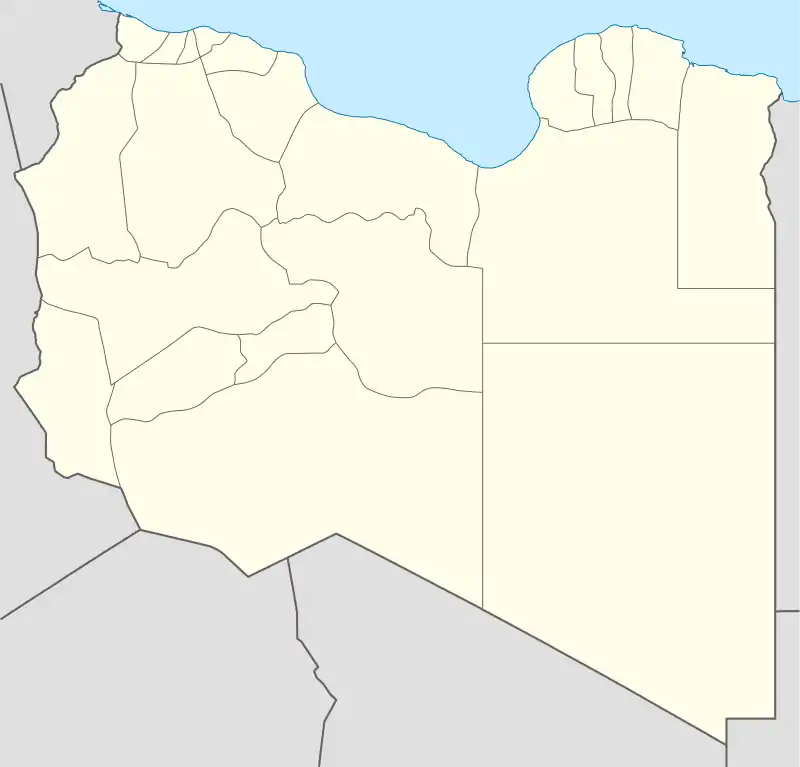| Atiq Mosque | |
|---|---|
المسجد العتيق | |
 Exterior of the mosque c. 1984 | |
| Religion | |
| Affiliation | Islam |
| Branch/tradition | Sunni Islam |
| Location | |
| Location | Awjila, Libya |
 Shown within Libya | |
| Geographic coordinates | 29°07′39″N 21°17′28″E / 29.127464°N 21.291016°E |
| Architecture | |
| Type | Mosque |
| Date established | 12th century |
| Materials | Mud brick and limestone |
The Atiq Mosque (Arabic: المسجد العتيق, lit. 'old mosque') is a mosque in the oasis village of Awjila, in the Sahara desert of the Cyrenaica region of eastern Libya. The mosque is located in the old city area of Awjila.[1] It dates from the 12th century and has unusual conical domes made of mudbrick and limestone.[2][1]
History
The region around Awjila was conquered by Arab Muslims under the leadership of Sidi 'Abdullāh ibn Sa'ad ibn Abī as-Sarḥ.[3] His tomb was established in Awjila around 650.[4][lower-alpha 1] The Arab chronicler Al-Bakri says that there were already several mosques around the oasis by the 11th century.[5]
_-_The_Mosque_of_Atiq.jpg.webp)
The present Atiq Mosque dates to the 12th century.[2] It was restored in the 1980s.[1]
Structure
The unusual mud brick building covers an area of 400 square metres (4,300 sq ft) and is roofed by 21 conical domes made of mud brick and limestone. Each dome has small openings so that light can enter the building.[1]
The walls are 40 centimetres (16 in) thick. Nine doors lead into the interior of the building, where the many pillars and arches create a spacious, light, cool and calm environment.[1] Beside the mihrab there is a recessed niche for the minbar, where the prayer leader stands. Mosques in Arabia and East Africa have similar minbar niches, which may indicate that the mosque builders followed the Ibadi school of Islam.[2]
See also
References
Notes
Citations
- 1 2 3 4 5 6 Ham 2007, p. 132.
- 1 2 3 Petersen 2002, p. 166.
- ↑ Awjila: Libyan Tourism.
- ↑ Mason 1974, p. 396.
- ↑ Mason 1974, p. 395.
Sources
- "Awjila". Libyan Tourism Directory. Archived from the original on 11 April 2013. Retrieved 7 March 2013.
- Batibo, Herman (2005). Language Decline And Death in Africa: Causes, Consequences And Challenges. Multilingual Matters. ISBN 978-1-85359-808-1.
- Chandra, Satish (1986). International Protection of Minorities. Mittal Publications. GGKEY:L2U7JG58SWT. Retrieved 24 March 2013.
- Falola, Toyin; Morgan, Jason; Oyeniyi, Bukola Adeyemi (2012). Culture and Customs of Libya. ABC-CLIO. ISBN 978-0-313-37859-1.
- Ham, Anthony (1 August 2007). Libya. Ediz. Inglese. Lonely Planet. p. 132. ISBN 978-1-74059-493-6.
- Mason, John Paul (October 1974). "Saharan Saints: Sacred Symbols or Empty Forms?". Anthropological Quarterly. The George Washington University Institute for Ethnographic Research. 47 (4): 390–405. doi:10.2307/3316606. JSTOR 3316606.
- Mason, John P. (Summer 1982). "Qadhdhafi's "Revolution" and Change in a Libyan Oasis Community". Middle East Journal. Middle East Institute. 36 (3): 319–335. JSTOR 4326424.
- Petersen, Andrew (11 March 2002). Dictionary of Islamic Architecture. Taylor & Francis. ISBN 978-0-203-20387-3.